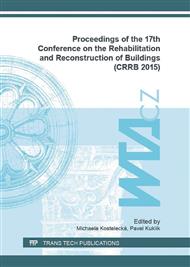p.35
p.40
p.44
p.51
p.59
p.64
p.72
p.78
p.86
Microscopy Measurement of Open Porosity as a Function of Hydrophobic Impregnation
Abstract:
In this paper open porosity as a function of hydrophobic properties was examined. It was measured three kinds of porous building materials which differ in their structure and properties. Especially, concrete samples such as: aerated concrete (denote as AC), normal strength concrete (denote as NSC) and ultra high performance concrete (denote as UHPC). We were focused on measurement of open porosity and distribution of pores in structure by microscopic method. The result clearly shows that concrete samples differ in among of pores, its geometric shape and deep and mainly in its distributions.
Info:
Periodical:
Pages:
59-63
Citation:
Online since:
September 2016
Authors:
Keywords:
Price:
Сopyright:
© 2016 Trans Tech Publications Ltd. All Rights Reserved
Share:
Citation:


